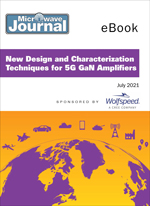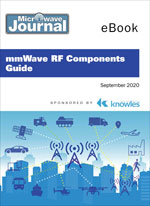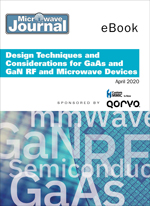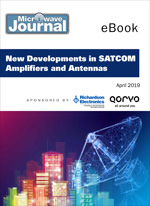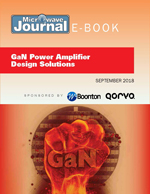Please note:
By downloading an eBook, the details of your profile will be shared with the sponsoring company and you may be contacted by them directly.
Impact of Amplifier Linearity on Communications Systems Performance – New Developments
For engineers and researchers working in the field of RF and microwave devices, the design considerations outlined in this eBook serve as a valuable resource. Practical insights and real-world applications offer a hands-on approach to implementing the latest strategies for achieving optimal amplifier linearity in communications systems. The “Impact of Amplifier Linearity on Communications Systems Performance” is a timely and indispensable guide for those seeking to stay at the forefront of technological progress in the ever-evolving world of communications. As we embrace the future of connectivity, this eBook equips its readers with the knowledge and skills needed to navigate the intricate landscape of amplifier design with confidence and innovation.
High Linearity Technologies Enabling 5G and Other Applications
This eBook covers several design trends and technologies with high linearity devices ranging from switching to power amplifiers to complete systems. The first two articles cover new RF SOI device technologies addressing 5G MIMO and mMIMO systems. The next article looks at what the perfect HF receiver look like today - one that combines all available technologies into the most modern concept of a software-defined receiver. The next article covers Improving Linearity of a Doherty Power Amplifier with a Dual-Bias Structure. The article after that continues to cover integrated PA topologies for 5G mMIMO. 5G NR RF front end design engineers can benefit from understanding these trends and aspects of the new RF hardware and technologies needed to address the new challenges of 5G, so the next article covers these aspects. Finally, the capabilities and impact of new SOI tunable filter ICs on the design of the RF chains of phased arrays are discussed.
Innovations in High Performance GaN for Aerospace and Defense
This eBook explores GaN applications and highlights the capabilities of the technology. The first few articles describe applications where GaN’s high power, high temperature and radiation tolerance may prove useful: LEO satellites, EW, and hypersonic weapons while the remaining articles cover “hands on” topics covering GaN technology.
High Performance GaN Amplifier Design Guide
To aid designers of GaN power amplifiers (PA), Wolfspeed has selected several recent articles published by Microwave Journal, creating this handy eBook reference. We begin with a survey of the RF GaN market written by the consulting firm Yole Développement. “The RF GaN Device Market: A Roller-Coaster Ride.” Then “A Dive into Integrated PA Topologies for 5G mMIMO,” written by Wolfspeed, discusses the benefit of using GaN rather than LDMOS and how best to design the GaN PA. The article “Broadband, High Efficiency, Class J Power Amplifier Design Method with Compensating Drain-Source Capacitance,” written by authors from Hangzhou University and the University of Kent, describes a single-ended GaN PA design covering the cellular bands from 1.4 to 3.6 GHz that achieves approximately 10 W output power, between 60 and 68 percent drain efficiency and an adjacent channel power ratio better than −30 dBc. The next article, “Doherty Power Amplifiers Move to mmWave,” written by PRFI, describes the design of an asymmetric Doherty PA MMIC for the 28 GHz 5G band. The design was processed using Wolfspeed’s 0.15 μm GaN on SiC foundry process. The next article, “The Maximally Efficient Amplifier,” written by Rohde & Schwarz, explores the theoretical circuit approaches for maximizing a PA’s efficiency: waveform engineering, supply modulation and load modulation. The eBook concludes with “Choosing the Right Signal Source for Reliable Measurements,” a cautionary reminder from Rohde & Schwarz that the quality of the signal source causes measurement uncertainty and error.
Improving RF GaN Success
GaN has become the dominant RF power technology in Defense applications and higher high performance commercial applications. Strategy Analytics forecasts GaN component revenue to approach $1.5 billion for Defense applications alone by 2030. Its performance characteristics support evolving battle philosophies that rely on higher operating frequencies, wider instantaneous bandwidths, better efficiency and higher linearity. This eBook takes a look at several new applications for GaN technology and some examples of optimizing GaN amplifier performance.
Improving RF GaN Success
Designing a semiconductor component is not easy: the myriad specifications, simulating performance, the cycle time through the wafer fab, packaging, designing and building the evaluation board, testing the circuit — all contributing to the total cost of development. With GaN being widely adopted for military and commercial systems, the RFIC industry has focused on the device physics, modeling and simulations tools to enable first-pass success with GaN devices. This eBook explores the topic compiling five recent articles published by Microwave Journal including simulation, device topologies, off-chip matching circuits and device models.
New Design and Characterization Techniques for 5G GaN Amplifiers
This eBook surveys the state of GaN and its use for 5G base stations, concluding with the day when GaN will be eyed for 6G systems operating at E-Band and above. The first article reviews the growth of GaN since Strategy Analytics began tracking it in 2007. Strategy Analytics forecasts continued growth driven by strong defense and 5G demand. The next article discusses DPD linearization challenges for 5G transmitters. A relevant example of GaN’s broadband capabilities is presented in a design article of a 10 W nominal PA covering 1.4 to 3.6 GHz, achieving 60 to 68 percent drain efficiency and adjacent channel power ratio better than −30 dBc. The eBook concludes with an application note on making accurate device load-pull measurements from 70 to 110 GHz. Accurate load-pull data is a key element of successful PA design, and while E- and W-Band frequencies may not seem relevant to today’s cellular PA designers, it won’t be long.
The Cellular GaN Era Has Arrived
The articles in this eBook make the case for GaN for cellular applications. It begins with two views of the market trends and how these translate into forecasts, from Yole Développement and Strategy Analytics. Since efficiency is so important to power amplifiers, a foundational article by Rohde & Schwarz reviews the fundamental mechanisms that can improve PA efficiency: waveform engineering, supply modulation and load modulation. Illustrating waveform engineering, an article from researchers at Huazhong University of Science and Technology describe the design of a dual-band, continuous inverse class F PA. The following article examines the topology options for mMIMO PAs. Looking to the future, it concludes with an article describing development of a 28 GHz, ½ W linear, asymmetric Doherty PA MMIC.
Design Innovations in mmWave MMICs
This eBook provides design advice on mmWave components and some examples of the new systems and applications where companies are providing interesting solutions. SOI is a semiconductor platform well suited for mmWave applications and so that is covered in the first article. Knowles offers design advice in several of the articles covering optimized solutions for many passive devices for mmWave applications. A unique liquid crystal steerable antenna system is also covered along with trends in millimeter phased arrays and MIMO radar. Another article looks at the role of satellites in 5G networks. Read this collection of articles for design advice and interesting examples of how mmWave components are being used in practical applications.
mmWave RF Components Guide
This eBook provides design advice on mmWave components and some examples of the new systems and applications where companies are providing interesting solutions. SOI is a semiconductor platform well suited for mmWave applications and so that is covered in the first article. Knowles offers design advice in several of the articles covering optimized solutions for many passive devices for mmWave applications. A unique liquid crystal steerable antenna system is also covered along with trends in millimeter phased arrays and MIMO radar. Another article looks at the role of satellites in 5G networks. Read this collection of articles for design advice and interesting examples of how mmWave components are being used in practical applications.
GaN Solutions for Wide Bandwidths and High Frequencies
This eBook covers new market and design trends in GaN technology starting off with semiconductor trends in sub-6 GHz 5G Networks where the wider bandwidths and high efficiency are favoring GaN technology in many cases. Then Cobham covers AESA phased array and MIMO radar trends and new design techniques are covered with a modular system approach. The next two articles cover high efficiency GaN amplifier design techniques started with efficiency enhancement mechanisms for various class amplifiers and then a mmWave Doherty amplifier design. The last article introduces large-signal model technology by Wolfspeed and other resources available for high-frequency designers.
5G Sub 6 GHz Technologies and Trends
This eBook starts off with a market outlook with a summary of Ericsson’s 2020 Mobility report followed by many of the sub-6 GHz 5G technologies including the evolution of cellular technology, semiconductor technologies supporting the RF functions, applications for satellites in 5G and dynamic spectrum sharing for easy transition from LTE to 5G. The eBook also addresses the key technologies to successful 5G rollouts and how massive MIMO works. These are educational articles to enable you to learn more about the RF technologies behind sub 6 GHz 5G rollouts.
Design Techniques and Considerations for GaAs and GaN RF and Microwave Devices
There have been many advancements in RF compound semiconductors in the last few years. GaAs designers have developed higher performance products to compete with GaN and with the mainstreaming of GaN technology, some companies are taking it to the next level with higher power levels than ever imagined before. From improvements in performance and levels of integration to reliability and packaging, this eBook examines many of these new developments and will update you on several advancements in high frequency compound semiconductor technology.
Design Ideas and Tradeoffs for 5G Infrastructure
This eBook addresses some of the challenges with design solutions that were published in Microwave Journal. Microlab looks at the challenges and solutions for network densification as small cells will need to be deployed in massive numbers to achieve 5G NR goals. The second article is written by Nokia about how microwave solutions are required to drive 5G deployment. Qorvo discusses the various technology tradeoffs for designing FWA arrays including beamforming techniques, front-end components and semiconductor materials. Lastly, Rohde & Schwarz looks at optimization techniques for Doherty power amplifier design as these are a prime choice for basestation applications.
Wideband Amplifier Design and Test Guide for 5G
New satellite and military communications systems plus 5G cellular communications will require much larger bandwidth signals in the hundreds of MHz versus current systems using tens of MHz of bandwidth, so new semiconductor amplifier designs need to support these wider bandwidth signals. However, designing and testing these types of devices is challenging. This eBook addresses some of the design and test challenges plus provides some solutions for wider bandwidth amplifier design and test giving RF/microwave designers better insight in this area.
New Developments in SATCOM Amplifiers and Antennas
This eBook covers new RF design techniques being used in the area of SATCOM. It starts off with an overview of defense technologies by Strategy Analytics followed by two articles on the design of GaN amplifiers for SATCOM including new GaN-on-diamond amplifiers and another on space qualified GaN amplifiers. And the final article takes a look at new antenna technologies that promise great improvements for SATCOM and other applications. Read this eBook to learn about these new trends in SATCOM design.
SATCOM GaN Power Amplifier Design
The first article in this eBook is written by Strategy Analytics’ Asif Anwar covering the military satellite terminal basics, market trends and the outlook for this market. With a major shift from GaAs to GaN as the semiconductor device material of choice, Norsat compares the two technologies covering the reasons for this shift and the advantages of GaN technology for SATCOM amplifiers. Another article covers the design of a broadband, highly efficient, GaN power amplifier. The last article reviews GaN SSPA technology for space-based applications covering the challenges to device design and reliability as they start to replace TWTs in this area. Read this eBook to learn about these important topics in SATCOM amplifiers.
GaN Power Amplifier Design Solutions
With RF GaN amplifier activity continuing to increase, this eBook provides six articles covering various design topics in commercial and military markets. The first two stories cover Aerospace & Defense applications with GaN being used in the Space Fence Radar System and as replacements for TWTAs in ECM systems. The next article takes a look at the adoption of GaN in the point to point microwave radio systems authored by Ericsson. With the high power densities achieved by GaN amplifiers, the thermal challenges can even be more critical than the electronic design issues so the next three articles look at addressing thermal challenges through heat sinking/mechanical design and various design techniques and solution to improve efficiency. We hope that this will improve your knowledge of GaN amplifier technology and thank Boonton and Qorvo for sponsoring this eBook.
5G Semiconductor Solutions - Infrastructure and Fixed Wireless Access
This eBook is a compilation of recent articles published by Microwave Journal on mmWave technology, automotive radar sensor trends and innovation, choosing the right PCB materials and configurations for high frequency automotive radars, the future of automotive radar testing and interference issues that need to be addressed.
Semiconductor Test Tips and Tricks
The semiconductor test market is undergoing tremendous pressure to reduce the cost of test and improve ROI as margins on low cost devices for applications such as IoT and memory decrease. In order to assist semiconductor test customers with educational articles on these and other related topics, this eBook covers some of the challenges test and measurement engineers are facing today.







